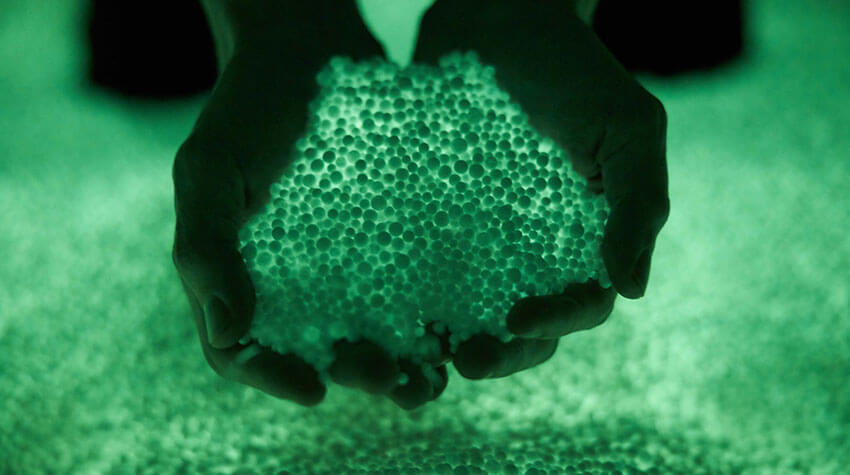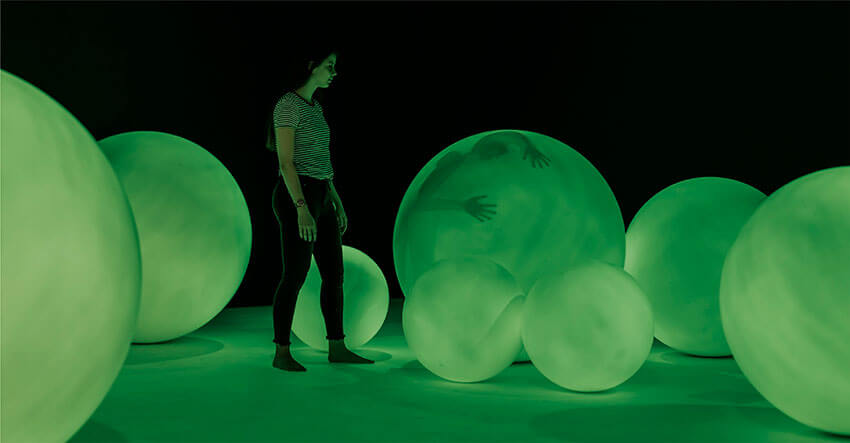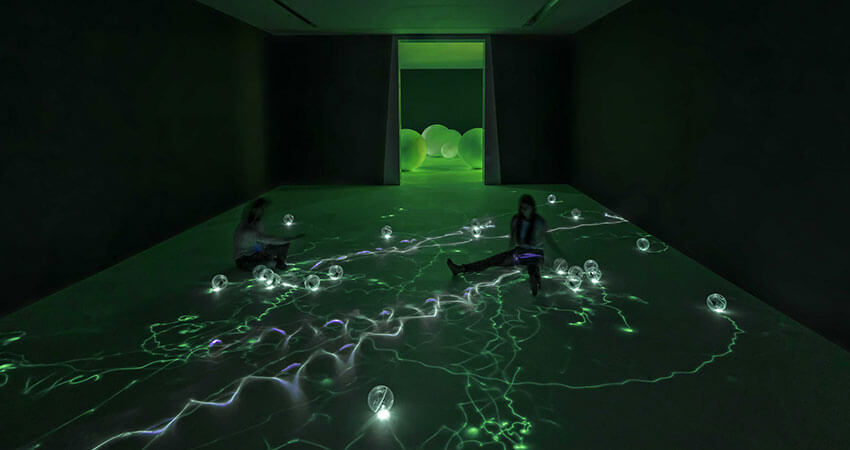Text by by Silvija Daniunaite

As you wander through eight hundred square meters of luminescent halls in the Groninger Museum, each bathed in an unfolding dance of phosphorescent blues and greens. Your eyes cannot escape the allure of a mesmerizing constellation of letters etched into a dimly lit museum wall: On spaceship earth, there are no passengers. We are all crew. In the midst of an escalating climate crisis, this oft-quoted phrase by media theorist and philosopher Marshall McLuhan stands as a haunting scream against the zeitgeist of contemporary times, crippled by immobilizing fear, abject nihilism and the ensuing political and socio-cultural paralysis in tackling the underlying causes of an unprecedented environmental breakdown.
Aside from uncanny imaginings of a dystopian future filled with vast stretches of barren landscape, this famous quote also encapsulates one of the guiding creative philosophies of Daan Roosegaarde, a world-renowned Dutch artist and innovator operating at the intersection of landscape architecture, (bio)technology, social design and installation art. Working around the concept of ‘techno-poetry’, Roosegaarde believes that bridging the alpha and the beta sciences is key to opening up new pathways for growth and development as well as driving meaningful social change.
To date, Roosegaarde’s oeuvre comprises a wide array of immersive in-situ installations, visualizing the majestic beauty of the natural world, albeit reimagined and reinvented in the urban jungle of the world’s most impressive cityscapes. Each a hybrid of living nature and technology, his social designs delve into ideas of conscious storytelling through responsive and interactive public spaces, designed to uproot humanity’s obliviousness to the natural world and harness the collective spirit of our environmental consciousness by forging an emotional bond between the audience and Roosegaarde’s own creative interventions into existing architectural structures and landscapes.
The mastermind behind air-purifying towers, energy-generating kites and self-powering dancefloors, light-emitting bicycle paths and ‘floating’ cities, Roosegaarde has been at the forefront of environmental innovation for most of his ground-breaking career as an artist, advocating for a more environmentally-sound and sustainable future.
Whilst raising ever more important questions about environmental ethics and the responsibility we bear towards the environment at large, Roosegaarde’s latest creative venture, Presence, is a bold step into previously uncharted territories, moving from the wilderness of the natural world to the much more intimate interior of the Groninger Museum in the Netherlands.


Upon entering the gallery space, visitors dissolve into a grid-patterned cyberspace pierced with beams of luminescent light, an atmosphere reminiscent of Piet Mondrian’s signature rectilinear compositions. As though an imitation of a copier, a sinister blue light scans the darkened museum hall, leaving a translucent imprint on the light-sensitive floor wherever the body of a wandering museum visitor blocks the light. In yet another room, Roosegaarde invites the audience to play around with mobile spherical orbs, allowing visitors to build their very own solar systems, floating in a mist of green and purple luminescence.
Perhaps the most demanding of all installations is an entirely deserted room, a somewhat perturbing alien landscape in the form of a white cube, snapping photos of its visitors as they explore vast stretches of uninterrupted surface, only to be momentarily stirred by a ghostly imprint of their own silhouette on the museum wall as it slowly withers away into invisible nothingness.
The exhibition as a whole is an enchanting odyssey through five ethereal dreamscapes, embracing the element of contrast to play with human perception of spatiality and relationality. The audience is thrust from utter darkness into phosphorescent luminosity, stumbles upon static structures in a room of massive rectangular blocks and dissolves into a whirl of bioluminescent jellyfish-like organisms in the next, only to later discover themselves swimming in an interstellar cloud of phosphorescent stardust. What lies at the heart of such intense perspectival changes is not merely aesthetic value but also an attempt to tap into our intellectual curiosity and to encourage active audience participation. Tearing down hierarchical barriers between the ‘ideal’ museum visitor and the displayed work of art, Roosegaarde makes the audience an integral part of his artworks’ identity, its DNA continuously mutating with each footstep, handprint or movement that the visitor makes.
You make the artwork and the artwork makes you, said Roosegaarde when asked about his creative approach, explaining how each installation is meant to awaken the visitors to their impact upon the natural world, while simultaneously nurturing their emotional intimacy with the surrounding landscape.
In its majestic totality, Roosegaarde’s oeuvre is a techno-poetic meditation on humanity’s ever-changing relationship with the environment. It is designed to bind the mind and the body in an intimate moment of deep introspection and emotional regeneration. And while the noble mission of Roosegaarde’s far-ranging explorations brings us one step closer to the type of cultural transformation that we so desperately need, the artist’s body of work also paints a telling portrait of a society afflicted by a deep cultural malaise – one of psychological and emotional silos that reinforce ideological blindness and breed imaginative deficiency, rendering us incapable of envisioning a healthier future for ourselves and our planet.
Wrapped up in selfish narcissism and willful ignorance, we have been slaughtering our planet only to satisfy our extravagant tastes and lavish desires, wreaking havoc upon our planet’s delicate balance in a brutal act of violence against ourselves, one another and our home. Hounded by humanity’s insatiable greed, nature has been objectified and commodified to serve the conveniences of modern consumer capitalism, a philosophy so horrifying as to leave us at a crossroads, where the very possibility of an imaginable future is more than oftentimes exchanged for a momentary bliss of a more comfortable existence in the present.


Somewhere along the way – having awakened, perhaps, to the sudden realization about the limitless potential of the human mind to forge ever more transformative and revolutionary pathways to a better life, yet blindly unaware of the intrinsically destructive power looming in its own creations – humankind has abandoned the cathartic ecstasy of living in harmonious unison with the natural world to instead colonize the vast wilderness of the earth in an unapologetic exercise of imperial power and genocidal dominion.
Travelling the road of gradual self-destruction, we have entered an era of mental pollution and spiritual impoverishment, sitting idly in the midst of an unprecedented ecological breakdown with a corrupted moral compass and a broken value system in our somewhat apathetic hearts. What lies at the core of the cataclysmic events brought forth by modern environmental degradation is not the death of entire ecosystems or the impending doom of climate change, but our spiritual and cultural disconnect from nature, as well as each other.
Uprooting and changing the fundamental systems that drive our planet towards irreparable environmental collapse necessitates profound cultural transformations – of our values, worldviews and beliefs – whereby nature becomes a matter of ethical and moral concern in the heart of each and every one of our planet’s inhabitants.
However inescapable the clutches of our moral and spiritual decadence might seem, ‘any human power can be resisted and changed by human beings,’ once said one of the most celebrated American sci-fi authors, Ursula Le Guin, and it is precisely in art, she continued, that the necessary resistance and change begin to blossom.
With his artistic gaze stretching far beyond rigid discipline categorization or pure aesthetic pleasure, Daan Roosegaarde has always been a visionary artist, unafraid to roam the terra incognita of the art world to bring forth innovative cultural narratives that continue to drive meaningful social change, develop sustainable activism and aid us in the battle against our cultural ills. While Presence was born out of Roosegaarde’s genuine concern for the declining health of our planet, his work is not looking to ‘solve’ our environmental crisis per se.
Rather, his creative energies are in pursuit of humanity’s long-dormant imaginative powers, which, when awakened from their current slumber, can help us realize a positive change of mindset and foster environmentally-conscious behaviour, allowing us to think and act as if we were, in fact, the crew on our one and only Spaceship Earth. It is precisely this ‘crew consciousness’ that will eventually enable us to close the yawning chasm of disconnect between humanity and nature, igniting the dawn of future worlds not only possible but entirely necessary.






